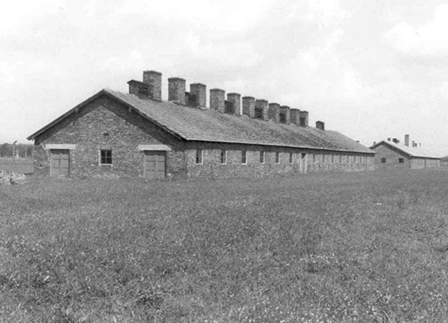Overview
- Caption
- Defendant Paul Sakowski at the Sachsenhausen concentration camp war crimes trial in Berlin.
- Date
-
1947 October 23 - 1947 November 01
- Locale
- Berlin, [Berlin] Germany
- Variant Locale
- Berlin-Buckow
Berlin-Mariendorf
Berlin-Ploetzensee
Berlin-Reinickendorf
Berlin-Tempelhof
Berlin-Wannsee
Berlin-Schlachtensee
Berlin-Duppel - Photo Credit
- United States Holocaust Memorial Museum, courtesy of Central Archive of the Federal Security Service
- Event History
- On October 23, 1947 fifteen former Sachsenhausen concentration camp personnel and one former prisoner were brought to trial before a Soviet Military Tribunal in Berlin. Among the defendants were Anton Kaindl, the former commandant, and Paul Sakowski, a kapo who had served as an executioner. The findings were announced on November 1, 1947 after only a brief trial. All sixteen were found guilty. Fifteen of the defendants were sentenced to life in prison with forced labor and one, to fifteen years in prison with forced labor.
https://www.ushmm.org/wlc/en/article.php?ModuleId=10007776.
Rights & Restrictions
- Photo Source
-
United States Holocaust Memorial Museum
Copyright: United States Holocaust Memorial MuseumProvenance: Central Archive of the Federal Security ServiceSource Record ID: Collections: RG-06.025*26Second Record ID: KGB Archives: N-19092, Appendix - - file 2294
Keywords & Subjects
Administrative Notes
- Biography
- Paul Sakowski was born in Breslau in 1920. In 1939, while a prisoner in Sachsenhausen, he offered his services to the camp administration, eventually aiding in the extermination of people in the camp. From November 1939 until March 1941 he was a prisoner overseer, during which time he mistreated prisoners, whipped them, withheld food, threw cold water on them, and kept them outside during the winter, and took part in executions. In December 1940 he became the unofficial camp executioner and oversaw the hanging of 42 Soviets and Poles. In September 1941 while working in the crematoria, he oversaw the shooting of thirteen thousand, five hundred Soviet POWs, then supervised the transport of corpses to the morgue, their searching there, and transfer to the crematoria. On 15 May 1942, he took part in the shooting of two hundred fifty Jews. From September 1943 until April 1945 he was a policeman in the Heinkelwerke, where his mistreatment and abuse of prisoners continued. It is estimated that during his time in the crematoria, he oversaw the burning of twenty-five thousand corpses. Following his trial by a Soviet Military Tribunal, he was sentenced to life in prison with forced labor.
- Record last modified:
- 2003-03-28 00:00:00
- This page:
- http://collections.ushmm.org/search/catalog/pa1099377



